Cheese and Green Chile Pupusas
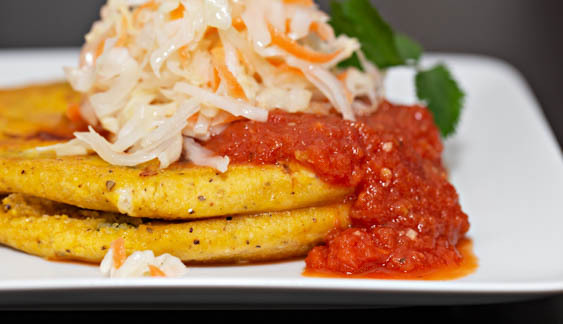
introduction
Masa griddlecakes filled with meat or cheese, pupusas are so crisp and compact they make tacos look like a total mess. And pupusa arrive on the plate with a full entourage, gliding on a generous ladle of salsa roja that has slipped to the bottom of the plate and topped with curtido, a silky cabbage slaw. An unimaginably delicious combination, pupusas and company are best consumed in haste while the individual elements retain their full character.
We are excited to be able to offer a recipe we think is as good or better than the best pupusas we’ve eaten. The mild roasted poblano chiles in the filling, while not strictly Salvadoran, bring the haunting specter of green chile into the melting cheese with riveting results. We use Henry Moore yellow hominy corn here (most restaurant pupusas are formed with white corn instant masa).
Cooking Remarks
Pupusas are clearly a project best approached over the course of a couple of days.
Salvadorans use pineapple vinegar for their curtido. It is available from Rancho Gordo. Pineapple vinegar is fruity and lovely, but apple cider vinegar makes a nice substitution.
Queso Oaxaca is a stretched cow’s milk cheese similar in flavor and texture to mozzarella. If you are able to find it (it can be ordered online here), grinding it in a food processor is more efficient than shredding it on a box grater. First, pull the cheese into strings by hand, then pulse in a food processor until it resembles small pebbles.
The filling and shaping handwork of pupusa takes a bit of practice. They like a bit of slip, so keep your hands wet and allow the dough to slide around—almost if you were throwing pottery.
You may also use multiple pans/griddles to speed along the cooking.
equipment mise en place
To make the curtido, you will need a digital kitchen scale, a kettle or medium saucepan, a medium heatproof bowl, and a colander.
To make the salsa, you will need a blender, a 12-inch skillet, and a small saucepan.
To make the pupusas, you will need a rimmed baking sheet; a medium bowl; parchment paper; a gallon-size zipper-lock bag; scissors; a small bowl; a digital kitchen scale; clean kitchen towels; a rolling pin; a small baking sheet (or pie plate); a heavy square or round griddle, preferably well-seasoned cast-iron; a pastry brush; and a wide metal spatula.
-
for the curtido:
-
8ounces thinly sliced green cabbage
-
2ounces peeled and shredded carrot (shredded on the large holes on a box grater)
-
1.5ounces thinly sliced sweet onion
-
Fine sea salt and freshly ground black pepper
-
2ounces pineapple vinegar (see Cooking Remarks) or apple cider vinegar
-
-
for the salsa:
-
1(28-ounce) can whole peeled San Marzano–style tomatoes
-
4ounces yellow onion, peeled and diced
-
1medium garlic clove, chopped
-
Pinch of dried Mexican oregano
-
1
-
2tablespoons avocado oil
-
Fine sea salt and freshly ground black pepper
-
-
for the pupusas:
-
8ounces poblano chiles
-
14ounces queso Oaxaca (see Cooking Remarks) or low-moisture whole-milk mozzarella cheese, shredded on the large holes of a box grater, then chopped to shorten the shreds
-
Fine sea salt
-
1recipe Spring Water Masa
-
Avocado oil, for griddling the pupusas
-
-
Make the curtido: Fill a kettle or a medium saucepan with about 1 quart of water, then bring it to a boil. In a medium heatproof bowl, toss together the cabbage, carrot, and onion. Pour enough boiling water over the vegetables to submerge them. Let stand for 1 minute, then drain in a colander set in the sink. Shake the colander and toss the vegetables to remove as much water as possible water. Wipe out the bowl and return the vegetables to it. Season with a scant ¾ teaspoon salt and ½ teaspoon pepper; toss to combine. Add the vinegar and toss again. Cover and refrigerate until ready to serve.
-
Make the salsa: Turn the tomatoes and their juice into a blender. Add the onion, garlic, oregano, and stock, then pulse until the ingredients have combined to form a flowing, rustic-looking sauce.
-
In a 12-inch skillet, heat the oil over medium-high heat until shimmering. Pour in the tomato mixture and “fry” the sauce, stirring frequently and reducing the heat if the sauce begins to sputter and pop, until it has reduced enough to lightly coat the back of the spoon, 15 to 20 minutes; you should have about 2½ cups. Stir in 1 teaspoon salt and ½ teaspoon pepper. Transfer the sauce to a small saucepan, cover and set aside until ready to serve (or, if making ahead, transfer the sauce an airtight container and refrigerate for up to 3 days).
-
Make the pupusas: Adjust an oven rack to about 4 inches from the heating element and heat the broiler. Cut off the top of each poblano chile, then slit the chile along its length. Open each chile as you would a book and, using the paring knife, remove and discard the seeds and ribs. Arrange the chiles skin side up on a rimmed baking sheet. Broil until the chile skins are charred and have loosened from the flesh, about 5 minutes. Cover the chiles (with a sheet of foil or by inverting a second baking sheet on top) and allow them to steam for about 10 minutes; this loosens their skins for easier peeling.
-
Transfer the chiles to a cutting board and peel away the skins. Finely dice the flesh (fig. 5.1), then measure 4 ounces into a medium bowl; reserve the remainder for another use. Add the cheese and salt to taste, then toss to combine; set aside.
-
Line a rimmed baking sheet with parchment paper. Cut eight 6-inch squares of parchment paper and set them aside. With scissors, remove the top of a gallon-size zipper-lock plastic bag, cutting just below the zipper. Cut away the side seams and bottom, creating two squares of plastic; set aside. Place a small bowl of water near your work area. Moisten your hands with the water, then divide the masa into eight evenly sized portions (each about 3.75 ounces) and roll each into a ball between your palms (fig. 6.1). Place the balls on the prepared baking sheet and cover with a damp, clean kitchen towel.
-
Moisten your hands, place a masa ball in the palm of your non-dominant hand, and press it into a 3-inch disk of even thickness. While slightly cupping the masa, use the thumb and first two fingers of your other hand to form the disk into a saucer-like shape with a slightly depressed center and a thicker, rounded rim, like a rolled-edge saucer. Grab a 2-ounce portion of the filling, squeezing it firmly so that it holds together, and place it in the center of the “saucer” (fig. 7.1). Wet your hands again. With the filled saucer still in your non-dominant hand, cup your palm to bring the saucer’s edges together and enclose the filling while gently pressing down on the filling with your other thumb (fig. 7.2). Cup the masa into a ball (fig. 7.3) and pinch to seal. Wet your hands again and patty-cake the ball back and forth to slightly flatten it. Lay one of the plastic sheets on the counter, set the pupusa in the center, and lay the second plastic sheet on top. Using a rolling pin, gently roll the pupusa into an evenly thick 5-inch disk, rotating as needed to form a neat circle. Set the pupusa on a parchment square on a small baking sheet and cover with a damp kitchen towel. Form and fill the remaining masa balls in the same way, stacking the pupusas on top of each other. (At this point, the towel can be removed, the baking sheet covered tightly with plastic wrap, and the pupusas refrigerated for up to 4 hours.)
-
When you are ready to griddle and serve the pupusas, adjust an oven rack to the middle position and heat the oven to 250 degrees. Set a wire rack in a rimmed baking sheet and place in the oven. Heat a heavy square or round griddle, preferably well-seasoned cast-iron, over medium-high heat for at least 5 minutes. Meanwhile, place the saucepan containing the salsa over low heat to gently warm (or if the sauce has been refrigerated, transfer it to a small saucepan, then warm it gently); keep the pan covered and stir occasionally.
-
When the griddle is hot, brush a pupusa with oil, lift it off the stack by its parchment liner, and invert it onto the griddle; peel off and discard the parchment (fig. 9.1). Oil and invert as many more pupusas as the griddle will comfortably accommodate. Brush the surfaces of the pupusas with oil and cook until the bottoms are spotty brown and crisped, about 4 minutes, adjusting the heat as needed. Using a wide metal spatula, flip the pupusas (fig. 9.2) and cook the second sides until spotty brown, about 4 minutes. As each pupusa is finished, slide it onto the rack in the warm oven. Cook the remaining pupusas in the same way. To serve, transfer the pupusas to individual plates, ladle warm sauce over, and top with curtido.
-
-
5.1

-
-
-
6.1

-
-
-
7.1
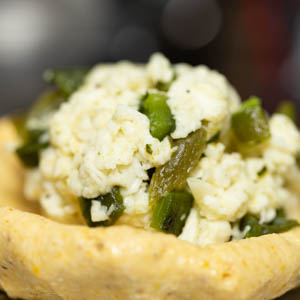
-
7.2
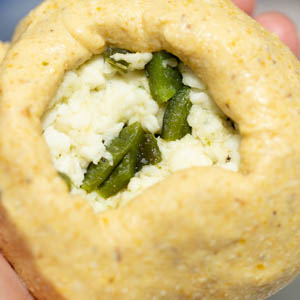
-
7.3
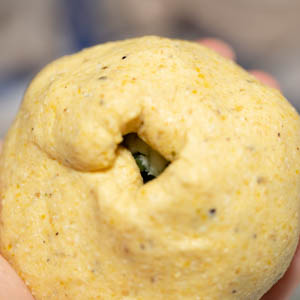
-
-
-
9.1
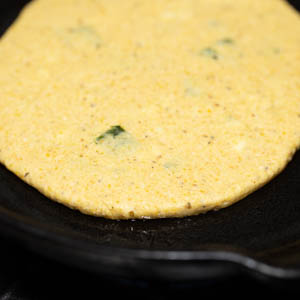
-
9.2
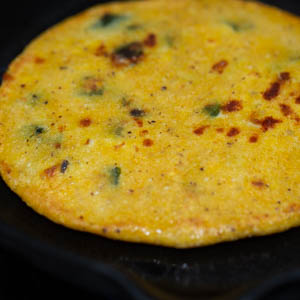
-